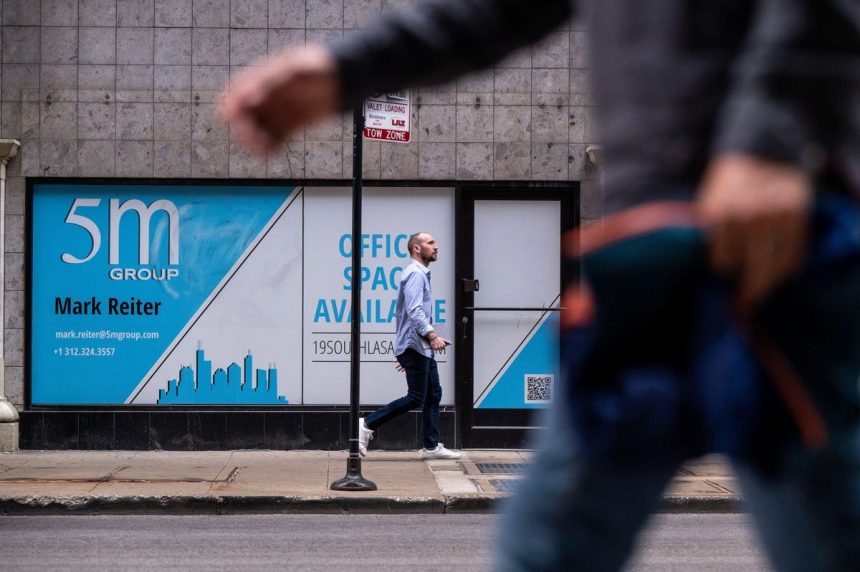This is the published version of Forbes’ Future of Work newsletter, which offers the latest news for chief human resources officers and other talent managers on disruptive technologies, managing the workforce and trends in the remote work debate. Click here to get it delivered to your inbox every Friday!
Despite CEOs’ best efforts to get workers back to the office, those empty looking office buildings are probably going to stay emptier than they were pre-pandemic. And demand could fall farther—even by moderate projections, according to a new report by the McKinsey Global Institute.
I wrote Wednesday about the report’s findings, which suggest that demand for office real estate could fall 13% from pre-pandemic levels, and up to 38% in more severe projections. Chatting with McKinsey associate partner Ryan Luby, I learned why he thinks hybrid work is here to stay: Indicators suggest the number of days employees prefer to work onsite (3.2 days per week) is really not that far off from the number of days they’re expect to have to go to the office after all this craziness is “over” (3.7 days)—if that ever happens.
In addition, office attendance has stabilized in recent months, and plenty of highly paid, senior-level bosses would still leave jobs if they had to be remote—suggesting plenty of powers-that-be want to keep things status quo. “We are in a new normal,” he told me. “What it takes to win in this environment is fundamentally different than three or four years ago.”
For more on McKinsey’s report, check out my story here, as well as our latest news, commentary and analysis on where work is headed.
Jena McGregor, Senior Editor, Leadership Strategy & Careers | @jenamcgregor
DIVERSITY AND INCLUSION
The ranks of Black female CFOs are a little bigger this week, with Kickstarter naming Lyft, EY and Cox Automotive alum Sindy Wilson to the job of finance chief July 12. With Everette Taylor as CEO, the announcement marks the rare CFO-CEO duo who are both Black. Read more about our exclusive here.
The impact of the Supreme Court’s affirmative action ruling will be felt for years to come. Contributors write that it could be a danger for DEI efforts, and that helping to develop programs after the ruling will be a growing business.
HUMAN CAPITAL
More than 40 Amazon Labor Union members in New York City are suing the union and its president, Chris Smalls, alleging he is violating the union’s constitution by handpicking an executive board rather than letting members vote to fill leadership posts, among other allegations. Forbes reached out to the union for comment, Molly Bohannon reports.
ARTIFICIAL INTELLIGENCE
A new report Tuesday from the Organization for Economic Cooperation and Development (OECD), a 38-member bloc, including the U.S. and Canada, found that more than a quarter of all jobs across the world’s wealthiest countries are in industries where artificial intelligence could replace many human workers, as the world sits on the brink of an “AI revolution.”
POLICY AND PRACTICE
A lawsuit from several delivery companies has temporarily blocked a law that would’ve increased delivery drivers wages to nearly $18 an hour, delivering a blow to the burgeoning movement for expanding drivers’ protections, reports William Skipworth.
WHAT’S NEXT: THOMSON REUTERS CHIEF PEOPLE OFFICER MARY ALICE VUICIC
Forbes sat down with the news and information giant’s chief people officer, Mary Alice Vuicic, to discuss generative AI and how the company is putting the new technology to work. The excerpts from our conversation below have been edited for length and clarity.
How much do you think AI will impact human resources?
I would say that this is, by far, the biggest technological transformation of my career. The closest [parallel] is probably the smartphone transformation. We’re so nascent in how this will transform the design of work and how companies are organized, how work is done. H.R. has an essential role to play around going past fear and looking at the opportunity and helping individuals and organizations understand how to adopt and use this.
But the smartphone revolution didn’t prompt all this fear about replacing people’s jobs. How are you thinking about that debate?
Generative AI unquestionably is a disruptive technology, but not in the way that many people are hyping it up to be. It will not replace jobs. But it will fundamentally change the way that many of them are done.
You don’t think it’s going to replace any jobs?
It doesn’t replace jobs. It replaces tasks. Work will be re-imagined and reorganized around the remaining tasks. … I think professionals and individual businesses will have to make choices around how to use that excess capacity. At Thomson Reuters, we’re leaning heavily into using that to up-level employees and accelerate the growth of what we’re doing for customers. There’s absolutely a continued role—I think an even more important role—for humans.
Can you talk more about how you’re specifically implementing AI?
The first first step, which I think is really essential for companies, is committing to trust and responsible AI. It’s not just an industry issue, it’s a societal imperative. … Then we move to our second step, which is awareness and education. Back in April, we held our very first global learning day, where we invited all 26,000 colleagues to participate in a day dedicated to learning about AI, [machine learning] and specifically generative AI. We had over 6000 people join live and thousands more participated asynchronously. Seventy-five percent of our colleagues who participated said they saw immediate opportunities to apply generative AI in their jobs. The idea was to spark a focus on leaning in, not leaning back.
Say I’m a breaking news reporter for Reuters. How do you convince me you are not going to create [an AI tool] that’s going to replace me?
Generative AI will definitely, as I said, automate tasks—lower level, more mundane tasks. Many professionals, whether you’re journalists, accountants, lawyers, in H.R., communications, don’t enjoy a lot of that mundane, more mundane kind of work or repetitive tasks, which generative AI is perfectly positioned to do.
In communications, where we’re leveraging generative A.I. to provide a first draft, the team is able to provide, I think, a better output of content, ensuring that we are capturing a broader range of data points. You can’t accept it as fact. We’ve got to do fact verification, but it’s actually creating greater productivity, greater output and it enables the team to up-level into better collaboration, better creativity, more complex problem solving.
FACTS + COMMENT
The Labor market is showing some signs of slowing down, but only slightly. The U.S. economy added 209,000 jobs last month, according to the latest jobs report, far short of the 240,000 economists estimated.
- December 2020: That’s the last time that few jobs were added in a month
- 3.6%: The new unemployment rate, slightly lower this month.
- There’s “nothing in the release that would change our expectation that the Fed has more work to do,” Vanguard economists Joseph H. Davis and Andrew Patterson wrote in emailed comments.
VIDEO
Keith Ferrazzi On The Secrets Of Successful Collaboration For Hybrid Teams
Watch
STRATEGIES + ADVICE
To promote the best candidates, make sure you’re promoting inclusivity.
How to make AI work for you—not against you.
Saturday is Youth Skills Day. Here’s how we need to prepare young people for the future of work, argues Randstad CEO Sander van ‘t Noordende.
Thanks for reading! Follow us on Twitter for by-the-minute updates on the latest business and financial news throughout the day.
Read the full article here










